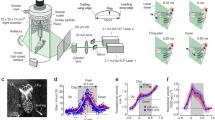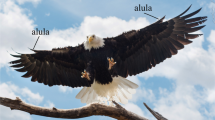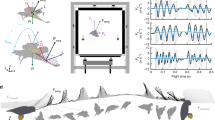Abstract
The flapping wings of flying birds and bats generate complex, unsteady air movements. These consist of well-defined vortex structures which are a necessary result of the aerofoil action of the wings, and which transport momentum below and behind the animal in reaction to the lift force which both balances weight and provides thrust1. Visualization of the vortex patterns enables the aerodynamic function of the flapping wings to be determined2–6. Here we present the results of experiments with small vespertilionids which allow the first description of the vortex wake of bats. The aerodynamics of flapping flight is similar between birds and bats: thrust is always generated during the downstroke, but wingbeat gait (the cyclic pattern of wing movements) and the mechanical function of the upstroke are determined by wing morphology. We present the first evidence from aerodynamic experiments that in an individual bat or bat species, upstroke function and wingbeat gait also vary with flight speed, with aerodynamic lift being generated during the upstroke at high speeds but not during slow flight. This result confirms that flapping gaits are not species-specific, but are selected according to the mechanical conditions experienced by the animal.
This is a preview of subscription content, access via your institution
Access options
Subscribe to this journal
Receive 51 print issues and online access
$199.00 per year
only $3.90 per issue
Buy this article
- Purchase on Springer Link
- Instant access to full article PDF
Prices may be subject to local taxes which are calculated during checkout
Similar content being viewed by others
References
Rayner, J. M. V. J. exp. Biol. 80, 17–54 (1979).
Kokshaysky, N. V. Nature 279, 146–148 (1979).
Spedding, G. R. Thesis, Univ. Bristol (1982).
Spedding, G. R., Rayner, J. M. V. & Pennycuick, C. J. J. exp. Biol. 111, 81–102 (1984).
Rayner, J. M. V. in Biona Report 5 (ed. Nachtigall, W.) 27–74 (Gustav Fischer, Stuttgart, in the press).
Rayner, J. M. V. in Konstruktionsprinzipien lebender und ausgestorbener Reptilien. Konzepte SFB 230 4 (eds Riess, J. & Frey, E.) 89–118 (University of Tübingen, 1985).
Rayner, J. M. V. in Recent Advances in the Study of Bats (eds Fenton, M. B., Racey, P. A. & Rayner, J. M. V.) (Cambridge University Press, in the press).
Norberg, U. M. J. exp. Biol. 65, 179–212 (1976).
Eisentraut, M. Z. wiss. Zool. 148, 159–188 (1936).
Aldridge, H. D. J. N. Thesis, Univ. Bristol (1985).
Author information
Authors and Affiliations
Rights and permissions
About this article
Cite this article
Rayner, J., Jones, G. & Thomas, A. Vortex flow visualizations reveal change in upstroke function with flight speed in bats. Nature 321, 162–164 (1986). https://doi.org/10.1038/321162a0
Received:
Accepted:
Issue Date:
DOI: https://doi.org/10.1038/321162a0
This article is cited by
-
Aerodynamics and mechanisms of elementary morphing models for flapping wing in forward flight of bat
Applied Mathematics and Mechanics (2015)
-
Aerodynamic mechanism of forces generated by twisting model-wing in bat flapping flight
Applied Mathematics and Mechanics (2014)
-
Costs of diving by wing and foot propulsion in a sea duck, the white-winged scoter
Journal of Comparative Physiology B (2008)
-
The hydrodynamics of water strider locomotion
Nature (2003)
-
Quantitative studies of the wakes of freely flying birds in a low-turbulence wind tunnel
Experiments in Fluids (2003)
Comments
By submitting a comment you agree to abide by our Terms and Community Guidelines. If you find something abusive or that does not comply with our terms or guidelines please flag it as inappropriate.



